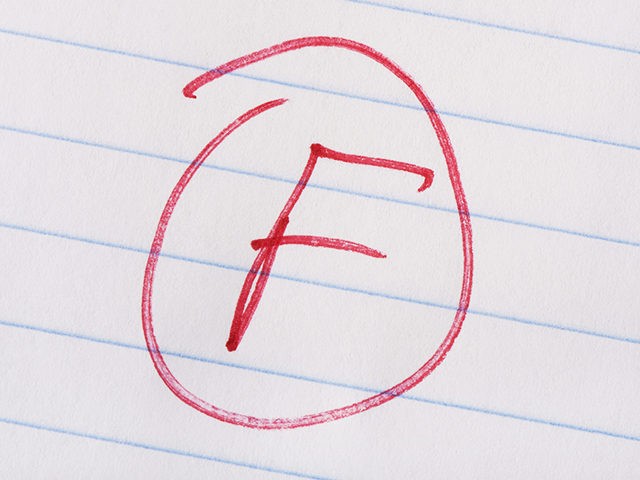A report from the Fairfax County Public Schools (FCPS) found that, since remote learning began in March due to the coronavirus pandemic, the percentage of F’s earned by middle and high school students in the district has jumped 83 percent.
The internal assessment conducted by the FCPS Office of Research and Strategic Improvement compared students’ grades from the first quarter of the 2019-2020 academic year with the grades earned in the first quarter of the 2020-2021 school year.
FCPS noted the analysis “follows on the heels of concerns locally and at the state and national level that student performance may be lower during the current year, when virtual instruction is prevalent, than in past years when in-person instruction was the norm.”
Since March, when the nation’s schools began closing because of the Chinese virus pandemic, FCPS has only offered remote learning for most of its students.
The analysis found that, since remote learning began, the percentage of F’s earned by middle school and high school students increased from six percent of all grades to 11 percent, a jump that represents an overall increase of 83 percent between the 2019 to 2020 school years.
FCPS explained the results:
The amount of increase among racial/ethnic, gender, and other student groups was highest among Students with Disabilities (111 percent increase), and English learner (106 percent increase) students and lowest among Black (63 percent increase) and White students (67 percent increase). Nonetheless, all groups showed increases in the percentage of F marks received during Q1 of the current year as compared to the prior year, indicating that more students were failing courses during the (primarily) virtual instruction period than had occurred when instruction was delivered in-person.
The analyses also specifically looked at performance in English and mathematics, since all children are required to take these classes. The findings here showed past performance was a significant factor:
“For English, the analyses indicated prior performance, course rigor, and school year collectively predicted current course performance,” FCPS stated. “For mathematics, the findings were similar. Collectively, prior marks, course rigor, and school year predicted current course marks.”
The report continued:
These analyses indicated that students who performed poorly this year were those that performed poorly last year and would likely have performed poorly even without the challenges presented to them this school year. These results expand on what was described above in Approach 1, confirming that the increases in students with Fs mostly reflect students who had performed poorly in the prior year, too. Those that performed well this school year were primarily those that performed well last school year.
Fairfax County Public Schools (FCPS) Superintendent Scott Brabrand said in a statement to the Washington Post that, while the district is working to remedy the problem areas, many students who were performing well academically before the pandemic are still earning high grades, and that others “who previously struggled in school … continue to do so.”
His statement echoed the report’s conclusion that “students who performed well previously primarily performed slightly better than expected during Q1 of this year.”
“In contrast, students who were previously not performing well, performed considerably less well,” the report observed. “A greater proportion of low-performing students received failing grades during Q1 than would have been expected based on patterns of marks in prior years.”
Results of the Nation’s Report Card continue to show that students who have been struggling in core areas of reading and math are declining further in these areas — even when they have been in school for in-classroom learning.
Dr. Peggy Carr, Associate Commissioner, notes that the lowest performing students–those readers who struggle the most–have made no progress in reading since the first assessment almost 30 years ago. Learn more: https://t.co/EWajchXvIH#NAEPDay pic.twitter.com/9zanK5fPmv
— NAEP (@NAEP_NCES) October 30, 2019
Results of the 2019 National Assessment of Educational Progress (NAEP), which tested grades 4, 8, and 12, showed that just about one in three U.S. 12th graders read proficiently and less than one in four are proficient in math.
Moreover, already struggling students, in the 25th percentile or lower — many of whom come from low-income families — declined even further in both reading and math, compared to four years ago.
The achievement gap — even while students have been taught in person in their schools — has widened between higher performing, mostly white and Asian students, and lower performing, mostly black and Hispanic students.
NEW: Over the last 10 years, higher performing students’ scores have increased and lower-performing students’ scores have decreased in math and reading. Read more about the growing gap in our latest blog: https://t.co/SL7gxP2aES#NAEP #edresearch #edpolicy #edchat pic.twitter.com/ywtfvF7uAv
— NAEP (@NAEP_NCES) October 30, 2019
In 2019, Dr. Peggy Carr, associate commissioner of the National Center for Education Statistics, noted results of the Nation’s Report Card assessment for students actually attending school.
“Over the past decade, there has been no progress in either mathematics or reading performance, and the lowest-performing students are doing worse,” Carr said. “In fact, over the long term in reading, the lowest-performing students—those readers who struggle the most—have made no progress from the first NAEP administration almost 30 years ago.”

COMMENTS
Please let us know if you're having issues with commenting.